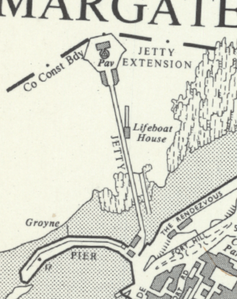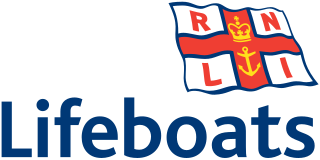
The Royal National Lifeboat Institution (RNLI) is the largest charity that saves lives at sea around the coasts of the United Kingdom, the Republic of Ireland, the Channel Islands, and the Isle of Man, as well as on some inland waterways. It is one of several lifeboat services operating in the same area.

Margate is a seaside town in Thanet, Kent, England, 15 miles (24.1 km) north-east of Canterbury, which includes Cliftonville, Garlinge, Palm Bay and Westbrook.
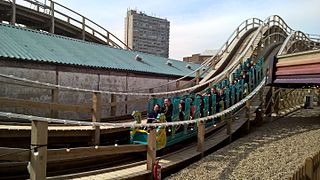
The Scenic Railway is a wooden roller coaster located at the Dreamland Amusement Park in Margate, UK. It first opened in 1920 and is the oldest roller coaster in the UK. The ride is distinctive compared to modern-day roller coasters, as a brakeman is still required to travel with the train to control its speed, manually applying brakes when needed. It is also one of only eight scenic railways in the world, and the UK's English Heritage granted the roller coaster Grade II listed status in 2002 and Grade II* listed status in 2011. The Scenic Railway was non-operational from 2006 until 2015 amid park closure and restoration following an arson attack.
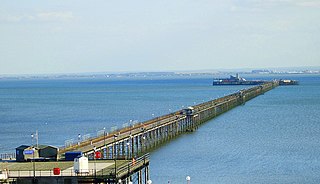
Southend Pier is a major landmark in Southend-on-Sea. Extending 1.33 miles (2.14 km) into the Thames Estuary, it is the longest pleasure pier in the world. The bill to build the new pier, to replace a previous timber jetty, received Royal Assent in May 1829 with construction starting in July 1829. The timber pier was replaced by an iron pier that opened to the public in August 1889. The Southend Pier Railway, opened in the early 1890s, was the first pier railway in the country.

Cromer Pier is a Grade II listed seaside pier in the civil parish of Cromer on the north coast of the English county of Norfolk, 25 miles (40 km) due north of the city of Norwich in the United Kingdom. The pier is the home of the Cromer Lifeboat Station and the Pavilion Theatre.

North Pier is the most northerly of the three coastal piers in Blackpool, England. Built in the 1860s, it is also the oldest and longest of the three. Although originally intended only as a promenade, competition forced the pier to widen its attractions to include theatres and bars. Unlike Blackpool's other piers, which attracted the working classes with open air dancing and amusements, North Pier catered for the "better-class" market, with orchestra concerts and respectable comedians. Until 2011, it was the only Blackpool pier that consistently charged admission.

Central Pier is one of three piers in the town of Blackpool, England, and was built in 1868.

Tenby Lifeboat Station is a lifeboat station in Tenby, Pembrokeshire, Wales that has been situated to the east of the town since 1852, three generations having been built; the original and updates in 1905 and 2005. The station currently houses two lifeboats.

Birnbeck Pier, also known as the 'Old Pier', is a pier situated on the Bristol Channel in Weston-super-Mare, North Somerset, England, approximately 18 miles (29 km) south-west of Bristol. It is the only pier in the country which links the mainland to an island, linking to Birnbeck Island, a 1.2 hectares rocky island just to the west of Worlebury Hill. The grade II* listed pier was designed by Eugenius Birch and opened in 1867. Birnbeck Pier is one of only six Grade II* piers surviving in the country. The gothic toll house and pierhead buildings were designed by local architect Hans Price. The pier has been closed to the public since 1994 and is now on the Buildings at Risk Register.
Margate was a "limb" of Dover in the ancient confederation of the Cinque ports. It was added to the confederation in the 15th century.

RNLB Lloyds II was an Oakley-class lifeboat of the Royal National Lifeboat Institution (RNLI) stationed at Sheringham in the English county of Norfolk from 8 October 1990 until April 1992, when she was replaced by the Atlantic 75 second generation Rigid Inflatable Boat (RIB) Manchester Unity of Oddfellows in April 1992. During the time that the Lloyds II was on station at Sheringham, she performed 13 service launches.
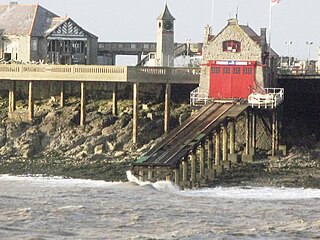
Weston-super-Mare Lifeboat Station is a lifeboat station at Weston-super-Mare in Somerset, England. For more than 100 years it was situated on Birnbeck Island but is now in a temporary building at Knightstone Harbour until a new lifeboat station can be built nearby. It is operated by the Royal National Lifeboat Institution (RNLI). The first lifeboat was stationed in the town in 1882, and since 1969 it has only operated inshore lifeboats (ILBs), currently a B-class and a smaller D-class (IB1).

The Southend-on-Sea lifeboat station is a lifeboat station at Southend-on-Sea in the English county of Essex, operated by the Royal National Lifeboat Institution (RNLI).
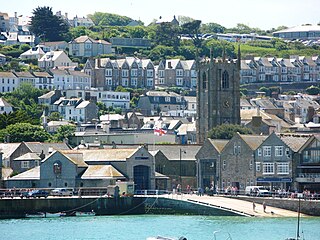
St Ives Lifeboat Station is the base for Royal National Lifeboat Institution (RNLI) search and rescue operations at St Ives, Cornwall in the United Kingdom. The first lifeboat was built for the town in 1840 and the present boathouse was opened in 1994. It operates a Shannon-class all weather boat (AWB) and a D-class (IB1) inshore lifeboat (ILB).
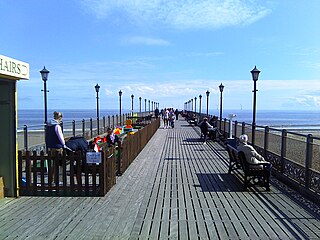
Skegness Pier is a pleasure pier in Skegness, Lincolnshire, England. Opened in June 1881, it was at the time the fourth longest in England, originally stretching a length of 1,844 ft (562 m). When originally built, it was a T-shaped pier with a saloon/concert hall at the pier head. Steamboat trips ran from the pier to Norfolk until 1910.

Beaumaris Pier is a pier in Beaumaris, Anglesey, North Wales.

1978 North Sea storm surge was a storm surge which occurred over 11–12 January causing extensive coastal flooding and considerable damage on the east coast of England between the Humber and Kent. Higher water levels were reached than during the devastating North Sea flood of 1953 from North Shields to King's Lynn, but values were lower towards the Thames. Locally severe flooding occurred in Lincolnshire, The Wash, north Norfolk and Kent. Improvements in flood protection following the devastating flood of 1953 meant that the catastrophic losses seen during that storm were not repeated. The storm caused severe damage to many piers along the east coast of England.

Royal National Life Boat Lord Southborough , was a Watson Class motor lifeboat of the Royal National Lifeboat Institution's (RNLI) fleet, which was stationed at Margate in the English county of Kent in the United Kingdom from 1925 to 1951. From 1951 she served in the RNLI Relief Fleet.
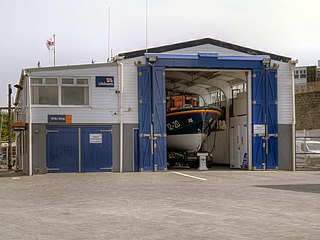
Margate Lifeboat Station is a Royal National Lifeboat Institution (RNLI) station located in Margate in the English county of Kent. The station is over 160 years old. Its crews have earned a number of gallantry awards, including five silver and 1 bronze RNLI medals for bravery.

Eastbourne Lifeboat Station is a Royal National Lifeboat Institution (RNLI) lifeboat station in the town of Eastbourne in East Sussex. Founded two years before the RNLI was established, the station has operated continuously since 1822 and its lifeboats have been responsible for saving over 700 lives. There are two active lifeboat stations in Eastbourne, an all-weather station with the Tamar-class lifeboatDiamond Jubilee at Sovereign Harbour and the D-class Lawrence and Percy Hobbs at the inshore lifeboat station a couple of miles to the west at Fisherman's Green. An older lifeboat station, west of Eastbourne Pier, is now used as an RNLI museum.





